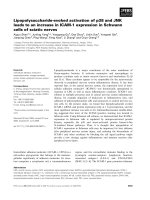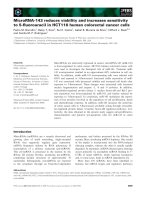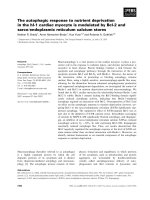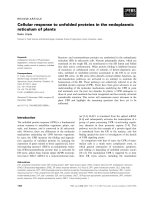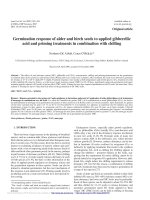Response: Sharpe, Goldsmith and Chalder fail to restore confidence in the PACE trial findings
Bạn đang xem bản rút gọn của tài liệu. Xem và tải ngay bản đầy đủ của tài liệu tại đây (559.21 KB, 5 trang )
Wilshire and Kindlon BMC Psychology
(2019) 7:19
/>
CORRESPONDENCE
Open Access
Response: Sharpe, Goldsmith and Chalder
fail to restore confidence in the PACE trial
findings
Carolyn E. Wilshire1*
and Tom Kindlon2
(10.1186/s40359-018-0218-3) The original article was published in BMC Psychology 2018 6:6
(10.1186/s40359-019-0288-x) This correspondence to this article has been published in BMC Psychology 2019 7:15
Abstract
In a recent paper, we argued that the conclusions of the PACE trial of chronic fatigue syndrome are problematic
because the pre-registered protocol was not adhered to. We showed that when the originally specific outcomes
and analyses are used, the evidence for the effectiveness of CBT and graded exercise therapy is weak. In a companion
paper to this article, Sharpe, Goldsmith and Chalder dismiss the concerns we raised and maintain that the original
conclusions are robust. In this rejoinder, we clarify one misconception in their commentary, and address seven additional
arguments they raise in defence of their conclusions. We conclude that none of these arguments is sufficient to justify
digressing from the pre-registered trial protocol. Specifically, the PACE authors view the trial protocol as a preliminary
plan, subject to honing and improvement as time progresses, whereas we view it as a contract that should not be
broken except in extremely unusual circumstances. While the arguments presented by Sharpe and colleagues inspire
some interesting reflections on the scientific process, they fail to restore confidence in the PACE trial’s conclusions.
Keywords: Clinical trial, Chronic fatigue syndrome, Myalgic encephalomyelitis, Graded exercise therapy, Cognitive
behavioral therapy, Methodology
Publications from the PACE trial reported that adding
cognitive behavioural therapy (CBT) or graded exercise
therapy (GET) to basic medical care significantly improved self-rated fatigue and physical function in a cohort of patients with chronic fatigue syndrome, and also
increased the likelihood of recovery. [1, 2] However, the
published analyses did not adhere to the pre-registered
trial protocol. [3] We recently reanalysed a portion of
the trial data using the original pre-registered outcome
measures. [4] We found that the evidence for the beneficial effects of CBT or GET was weak, and did not reach
the threshold of statistical significance after correcting
for the number of originally planned comparisons. Neither treatment significantly increased the rate of recovery. We also raised concerns about the trial’s heavy
reliance on self-report measures, which introduces a significant source of bias when a trial is not blinded.
* Correspondence:
1
School of Psychology, Victoria University of Wellington, P.O. Box 600,
Wellington, New Zealand
Full list of author information is available at the end of the article
In their recent response to our reanalysis, Sharpe,
Goldsmith and Chalder ([5]) dismiss the concerns we
raised in our paper and maintain that the conclusions of
the PACE trial are robust.
Before addressing their arguments, we first clarify one
point. The PACE trial also examined a novel behavioural
treatment, called adaptive pacing therapy (APT), which
did not yield reliably greater improvement than medical
care alone. Sharpe et al. appear to believe that we excluded the APT trial arm from our analyses. This was
not the case. The omnibus analyses reported in our
paper always included the APT arm. We simply chose
not to comment any further on those results, because
they were not at issue. Our approach is stated clearly in
the Methods section:
“All omnibus analyses … included the adaptive pacing
therapy group, because it forms part of the trial
design.” ([4], p. 4).
Having addressed this misunderstanding, let us consider
Sharpe et al.’s seven remaining arguments in defence of
© The Author(s). 2019 Open Access This article is distributed under the terms of the Creative Commons Attribution 4.0
International License ( which permits unrestricted use, distribution, and
reproduction in any medium, provided you give appropriate credit to the original author(s) and the source, provide a link to
the Creative Commons license, and indicate if changes were made. The Creative Commons Public Domain Dedication waiver
( applies to the data made available in this article, unless otherwise stated.
Wilshire and Kindlon BMC Psychology
(2019) 7:19
the trial’s original conclusions. [5] Many of these were
explicitly addressed in our original paper [4], and where
this is the case, we refer to the relevant section.
Argument 1: That the changes to the outcome
measures were insubstantial, and there is no
reason to prefer the original measures to the
modified ones
The pre-registered primary outcome measure was
whether participants met the specified threshold for improvement in self-reported fatigue and physical function.
Several years after trial preregistration, the investigators
decided this measure was “hard to interpret” ([6], p. 25).
They replaced it with the continuous scores generated
by the two original self-report scales, and they also
modified the scoring method for the fatigue scale. [5] In
addition, they substantially loosened the definition of recovery used in secondary analyses, making it much easier for patients to qualify as recovered. [2] These
changes are clearly not insubstantial. Further, as we
showed in our paper, all of them resulted in more successful outcomes than would have been obtained using
the pre-registered measures. [4]
Sharpe et al. argue that the pre-specified outcome
measures are “no more valid” than the modified ones
([5], p. 4). This argument is puzzling. The purpose of
pre-registration is to prevent researchers from altering
their outcome measures in ways that favour their hypotheses, after they have begun to observe the trial’s
progress. Therefore, all other things being equal, measures that are stipulated ahead of time will always trump
those formulated after the fact. Sharpe et al. offer the
justification that changing the scoring method for the fatigue scale made it “more accurate and sensitive to
change” ([5], p. 1). However, they provide no evidence to
support this claim.
The concept of pre-registration forms the cornerstone
of a good clinical trial, and this is the reason it is so vital
to get good statistical advice before the trial begins, especially on matters such as the sensitivity, validity and interpretability of the primary outcome measures. Of course, it
is perfectly acceptable to report additional, exploratory
analyses that come to mind at a later date, but these
should not replace the originally-specified measures.
An additional reason to prefer the pre-registered primary outcomes is that they formed the basis of the
power analyses conducted to determine sample size.
Given that the trial was estimated to be sufficiently
well-powered to detect effects on a binary outcome
measure, the failure to observe such effects reliably is of
central interest, and should have been highlighted in the
trial publications.
With regard to the recovery measure, we previously
addressed all of Sharpe et al.’s justifications for altering
Page 2 of 5
these in our original paper, and see no need to repeat
those arguments here (see [4] p. 8, see also [7, 8]). To
summarise, Sharpe et al. “prefer” their modified definition
because it generates similar rates of recovery to previous
studies, and is also more consistent with “our clinical experience” ([5], p. 6). Clearly, it is not appropriate to loosen
the definition of recovery simply because things did not
go as expected based on previous studies. Researchers
need to be open to the possibility that their results may
not align with previous findings, nor with their own preconceptions. That is the whole point of a trial. Otherwise,
the enterprise ceases to be genuinely informative, and becomes an exercise in belief confirmation.
Argument 2: That the changes to the outcome
measures were acceptable because certain
procedures were followed
The various changes were fully detailed in a separate
document published in 2013 ([9]), which Sharpe et al.
claim was approved by the trial steering and data monitoring committees. They believe that no further justification is required.
For the reasons outlined above, pre-registered primary
outcome measures have a special status in science,
which is devalued if we allow researchers to alter them
without strong justification. Administrative approval by
a committee is simply not sufficient. In our paper, we
showed that the investigators’ scientific justifications
failed to stand up to careful scrutiny (see [4], pp. 7–8).
And clearly, a document published in 2013 - two years
after the primary results were reported – simply cannot
be used as a replacement for the original pre-registered
trial protocol.
Argument 3: That our reanalysis was
methodologically flawed
Putting aside the erroneous criticism regarding the APT
arm, Sharpe and colleagues raised three further criticisms of our reanalysis. The first was that we did not adhere to “an a priori analysis plan” ([5], p. 1). This claim
is puzzling, because of course we followed the investigators’ own analysis plan as set out in their trial protocol –
or to be precise, we followed it as closely as was possible,
given the data we had available. All our decisions were
based on the best possible fit to what was stipulated in
the protocol, or where no guidance was provided, we referred to other trial publications. All these decisions are
fully documented in our paper ([4], p.4).
Second, Sharpe et al. criticise our method of correcting
for multiple comparisons, which took into account all
six planned comparisons specified in the original trial
protocol. They argue that a gentler correction was more
appropriate because we were primarily interested in only
two comparisons. However, again, our objective was to
Wilshire and Kindlon BMC Psychology
(2019) 7:19
report the results that would have been obtained if the
trial protocol had been adhered to. Since there were six
comparisons planned in that protocol, six is the appropriate number to correct for.
Sharpe et al.’s final criticism was that our analysis “only
used part of the trial dataset” ([5], p. 1). It is correct that
we did not have access to data for several stratification
variables (e.g., centre location, therapist). However, we explored the possible impact of these omissions in our paper,
concluding that it was likely to be minimal ([4], pp. 4–5).
The reason our dataset was so limited was because the
PACE investigators had been unwilling to share their data.
The (small portion of) data we analysed was made available only after a successful application under the UK Freedom of Information Act. [10]
Sharpe et al. appear to prefer their own, unpublished
analysis of the original primary outcome measures,
which they conducted in 2016, shortly after they had
been directed to release the relevant data. [5]. However,
their method of analysis diverged in several substantive
ways from the preregistration method. Our analysis is
therefore to be preferred.
Argument 4: That the absence of treatment
effects at long-term follow-up is of no
importance; what matters is that scores did not
actually decline
A 2015 paper reported that, at long-term follow-up,
there were no longer any significant differences amongst
the trial arms. [11] Sharpe et al. dismiss this null result,
arguing that additional, optional treatments given after
the trial’s conclusion may have obscured any real treatment effects. [5] Instead, they emphasise the fact that
numerical scores did not significantly decline between
the trial end point and long-term follow-up. There are
two problems with this reasoning. The first is that there
was no evidence to support the speculation that
post-trial therapy obscured genuine group differences (in
our paper, we showed that the pattern of results was
much the same when participants who received substantial additional post-trial therapy were excluded). Second,
in a clinical trial, it is inappropriate to directly compare
scores at two timepoints, especially when the number of
drop-outs is large (almost a quarter of all participants)
and almost certainly non-random. The only defensible
conclusion here is that the small self-reported benefits
of CBT and GET over the other treatment arms were no
longer evident at long-term follow-up.
Argument 5: That there is no reason to be
concerned about bias associated with the trial’s
reliance of self-report measures
In our paper, we argued that because the PACE trial was
non-blinded, and only CBT and GET participants were
Page 3 of 5
told their treatments were “effective”, then any
self-reported improvements are likely to be biased.
Sharpe et al. believe that any such bias would be small,
because: a) participants did not just give global ratings,
but rather answered specific questions about their fatigue and physical function; and b) other, secondary
self-report measures patterned in a similar way. They
appear to be unaware that biases can be observed on a
wide range of different kinds of self-report measures, including symptom-specific ones, and that they generally
operate in the same direction across all types of
self-report measures (see [12] for a review and metanalysis). When assessing whether self-reported measures are
influenced by bias, we must examine whether they pattern in a similar way to those observed on more objective measures (e.g., estimates of physical fitness, activity
levels). However, on the majority of the objective measures examined in the PACE trial, CBT and GET fared
no better than the other treatment arms (for discussion,
see [4] p. 10).
Sharpe and colleagues also repeat the argument that
CBT and GET participants did not have higher expectations than other participants at trial outset. We addressed this argument in our paper, and showed that
information provided during CBT and GET would have
been likely to significantly heighten those expectations
(see [4], p. 9).
Argument 6: That the PACE trial findings are
robust, because they are in line with both
previous and subsequent trials
Sharpe et al. believe that because the PACE trial’s findings
were consistent with other studies examining similar interventions, that this demonstrates their robustness. Of
course, convergence with previous findings is not in itself
proof of sound methodology. Also, these studies were subject to the same problems as the PACE trial – plus some
additional ones - so it is not at all surprising that they also
yielded positive outcomes. The majority were not
pre-registered, were based on small samples and were
problematic in various other ways (e.g. use of a passive
control condition, significant loss of participants to
follow-up). When we also consider that positive outcomes
are more likely to be published than negative ones, then
this body of evidence begins to look very problematic
indeed.
Criticisms of the trial are based on a principled
objection to “psychological” explanations of
chronic fatigue syndrome and are therefore
invalid
Sharpe and colleagues suggest that objections to the
PACE trial findings (including, presumably our critique)
may stem from a principled aversion to “psychological”
Wilshire and Kindlon BMC Psychology
(2019) 7:19
models of CFS. They maintain that the treatments
trialled were theory-neutral, and that the trial findings
do not speak to the question of illness causation.
The issue of ideological bias is an important one. But
before we address it, one point needs clarification. The
treatments tested in the PACE trial were not
assumption-free. CBT and GET were explicitly based on
a behavioural/deconditioning model of CFS, which assumes that there is no underlying disease process ([1]),
and that the patient’s thoughts, feelings and behaviours
are the primary factors maintaining the illness. The relevant therapy manuals make this position explicit. For example, the CBT participants’ manual tells them that
“there is nothing to stop your body from gaining
strength and fitness” ([13], p. 31). The GET manual assures patients that increasing activity will not cause any
harm ([14], p.79). If PACE’s behavioural/deconditioning
model of CFS proved to be unfounded, then these interventions would need to undergo substantial modification
– and the trial’s conclusions would not be generalizable
to these new interventions.
Turning now to ideology, the PACE trial investigators
began work on the trial with the firm belief that
thoughts, feelings and behaviours were the central perpetuators of CFS, and that psychological interventions
could reverse the illness ([15–19]; see also [20] for
discussion). In contrast, we approached our analysis
from a more conservative, sceptical perspective: we
considered that a false positive conclusion regarding
the benefits of CBT and GET could be harmful for
patients. For example, it could limit patients’ treatment options and reduce the opportunities for future
research into new treatments. Readers can consider
the original findings and the reanalysis in the context
of these two very different perspectives and draw
their own conclusions.
Conclusion
New arguments presented by Sharpe et al. [5] inspire
some interesting reflections on the scientific process,
but they fail to restore confidence in the PACE trial’s
original conclusions. The unjustified optimism surrounding CBT and GET – fuelled by the PACE trial
publications – has almost certainly hindered the
search for more effective treatments. Patients with
this illness suffer terribly and they are desperate for
treatments that really work. It is time to turn our attention to other approaches.
In addition, many of the issues discussed above have
importance that goes well beyond CBT, GET and even
chronic fatigue syndrome. In the field of psychology,
there is a growing awareness that some of our scientific
practices are problematic, and that serious reform is
needed to improve the quality of our evidence base.
Page 4 of 5
[21–24] The current rejoinder touched on several central themes in this methodological debate, including the
potential dangers of diverging from a preregistered
protocol, the subtle biases introduced by researchers’
own beliefs and allegiances, and also the problems associated with the use of self-report measures. It is likely
that the debate concerning the PACE trial will have implications reaching far beyond the illnesses and treatments under investigation.
Acknowledgements
Not applicable.
Funding
None to declare.
Availability of data and materials
Not applicable.
Authors’ contributions
CW and TK contributed equally to this response. Both authors read and
approved the final manuscript.
Ethics approval and consent to participate
Not applicable.
Consent for publication
Not applicable.
Competing interests
CW and TK are both authors on Wilshire et al. [4]. TK works in a voluntary
capacity for the Irish ME/CFS Association.
Publisher’s Note
Springer Nature remains neutral with regard to jurisdictional claims in
published maps and institutional affiliations.
Author details
1
School of Psychology, Victoria University of Wellington, P.O. Box 600,
Wellington, New Zealand. 2Irish ME/CFS Association, Dublin, Republic of
Ireland.
Received: 7 March 2019 Accepted: 19 March 2019
References
1. White PD, Goldsmith KA, Johnson AL, Potts L, et al. Comparison of adaptive
pacing therapy, cognitive behaviour therapy, graded exercise therapy, and
specialist medical care for chronic fatigue syndrome (PACE): a randomised
trial. Lancet. 2011;377(9768):823–36.
2. White PD, Goldsmith K, Johnson AL, Chalder T, Sharpe M. Recovery from
chronic fatigue syndrome after treatments given in the PACE trial. Psychol
Med. 2013;43(10):2227–35.
3. White PD, Sharpe MC, Chalder T, DeCesare JC, Walwyn R. Protocol for the
PACE trial: a randomised controlled trial of adaptive pacing, cognitive
behaviour therapy, and graded exercise as supplements to standardised
specialist medical care versus standardised specialist medical care alone for
patients with the chronic fatigue syndrome/myalgic encephalomyelitis or
encephalopathy. BMC Neurol. 2007;7:1.
4. Wilshire CE, Kindlon T, Courtney R, Matthees A, Tuller D, Geraghty K, Levin B.
Rethinking the treatment of chronic fatigue syndrome—a reanalysis and
evaluation of findings from a recent major trial of graded exercise and CBT.
BMC Psychol. 2018;6(1):6.
5. Sharpe M, Goldsmith KA, Chalder T. The PACE trial of treatments for chronic
fatigue syndrome: a response to WILSHIRE et al. BMC Psychol. 2019;7:15.
6. White PD, Chalder T, Sharpe M. The planning, implementation and
publication of a complex intervention trial for chronic fatigue syndrome:
the PACE trial. BJPsych Bull. 2015;39(1):24–7.
Wilshire and Kindlon BMC Psychology
7.
8.
9.
10.
11.
12.
13.
14.
15.
16.
17.
18.
19.
20.
21.
22.
23.
24.
(2019) 7:19
Wilshire C, Kindlon T, Matthees A, McGrath S. Can patients with chronic
fatigue syndrome really recover after graded exercise or cognitive
behavioural therapy? A critical commentary and preliminary re-analysis of
the PACE trial. Fatigue. 2017;5(1):43–56.
Wilshire C, Kindlon T, McGrath S. PACE trial claims of recovery are not
justified by the data: a rejoinder to Sharpe, Chalder, Johnson, goldsmith and
white (2017). Fatigue. 2017;5(1):62–7.
Walwyn R, Potts L, McCrone P, Johnson AL, DeCesare JC, Baber H,
Goldsmith K, Sharpe M, Chalder T, White PD. A randomised trial of adaptive
pacing therapy, cognitive behaviour therapy, graded exercise, and specialist
medical care for chronic fatigue syndrome (PACE): statistical analysis plan.
Trials. 2013;14(1):386.
Queen Mary University of London (QMUL): Statement: disclosure of PACE
trial data under the freedom of information act. 2016. .
uk/media/news/2016/smd/statement-disclosure-of-pace-trial-data-underthe-freedom-of-information-act-1.html. Accessed 22 Mar 2019.
Sharpe M, Goldsmith KA, Johnson AL, Chalder T, Walker J, White PD.
Rehabilitative treatments for chronic fatigue syndrome: long-term follow-up
from the PACE trial. Lancet Psychiatry. 2015;2(12):1067–74.
Hróbjartsson A, Emanuelsson F, Thomsen AS, Hilden J, Brorson S. Bias due
to lack of patient blinding in clinical trials. A systematic review of trials
randomizing patients to blind and nonblind sub-studies. Int J Epidemiol.
2014;43(4):1272–83.
Burgess M, Chalder T. PACE manual for participants: cognitive behavioural
therapy. 2004. Accessed 22 Mar 2019.
Bavinton J, Dyer N, White PD. PACE manual for participants: graded exercise
therapy. 2004. Accessed 22 Mar 2019.
Deale A, Chalder T, Marks I, Wessely S. Cognitive behavior therapy for
chronic fatigue syndrome: a randomized controlled trial. Am J Psychiatry.
1997;154:408–14.
Deale A, Chalder T, Wessely S. Illness beliefs and treatment outcome in
chronic fatigue syndrome. J Psychosom Res. 1998;45:77–83.
Fulcher KY, White PD. Randomised controlled trial of graded exercise in
patients with the chronic fatigue syndrome. BMJ. 1997;314:1647–52.
Sharpe M, Hawton K, Simkin S. Cognitive behaviour therapy for the chronic
fatigue syndrome: a randomised controlled trial. BMJ. 1996;312:22–6.
Wessely SC, Hotopf M, Sharpe M. Chronic fatigue and its syndromes. Oxford:
Oxford University Press; 1998. p. 428.
Wilshire C. The problem of bias in behavioural intervention studies: lessons
from the PACE trial. J Health Psychol. 2017 Aug;22(9):1128–33.
Pashler H, Wagenmakers EJ. Editors’ introduction to the special section on
replicability in psychological science: a crisis of confidence? Perspect
Psychol Sci. 2012;7(6):528–30.
Ioannidis JP. Why science is not necessarily self-correcting. Perspect Psychol
Sci. 2012;7(6):645–54.
Chambers C. The seven deadly sins of psychology: a manifesto for reforming
the culture of scientific practice. In: Princeton University Press; 2017.
Hughes BM. Psychology in crisis. In: Macmillan International Higher
Education; 2018.
Page 5 of 5


